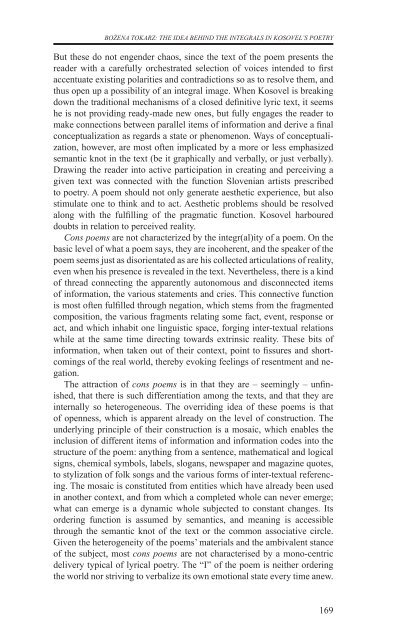razprave (pdf) - Društvo za primerjalno književnost - ZRC SAZU
razprave (pdf) - Društvo za primerjalno književnost - ZRC SAZU
razprave (pdf) - Društvo za primerjalno književnost - ZRC SAZU
- No tags were found...
Create successful ePaper yourself
Turn your PDF publications into a flip-book with our unique Google optimized e-Paper software.
Bożena Tokarz: The Idea behind the Integrals in Kosovel’s PoetryBut these do not engender chaos, since the text of the poem presents thereader with a carefully orchestrated selection of voices intended to firstaccentuate existing polarities and contradictions so as to resolve them, andthus open up a possibility of an integral image. When Kosovel is breakingdown the traditional mechanisms of a closed definitive lyric text, it seemshe is not providing ready-made new ones, but fully engages the reader tomake connections between parallel items of information and derive a finalconceptuali<strong>za</strong>tion as regards a state or phenomenon. Ways of conceptuali<strong>za</strong>tion,however, are most often implicated by a more or less emphasizedsemantic knot in the text (be it graphically and verbally, or just verbally).Drawing the reader into active participation in creating and perceiving agiven text was connected with the function Slovenian artists prescribedto poetry. A poem should not only generate aesthetic experience, but alsostimulate one to think and to act. Aesthetic problems should be resolvedalong with the fulfilling of the pragmatic function. Kosovel harboureddoubts in relation to perceived reality.Cons poems are not characterized by the integr(al)ity of a poem. On thebasic level of what a poem says, they are incoherent, and the speaker of thepoem seems just as disorientated as are his collected articulations of reality,even when his presence is revealed in the text. Nevertheless, there is a kindof thread connecting the apparently autonomous and disconnected itemsof information, the various statements and cries. This connective functionis most often fulfilled through negation, which stems from the fragmentedcomposition, the various fragments relating some fact, event, response oract, and which inhabit one linguistic space, forging inter-textual relationswhile at the same time directing towards extrinsic reality. These bits ofinformation, when taken out of their context, point to fissures and shortcomingsof the real world, thereby evoking feelings of resentment and negation.The attraction of cons poems is in that they are – seemingly – unfinished,that there is such differentiation among the texts, and that they areinternally so heterogeneous. The overriding idea of these poems is thatof openness, which is apparent already on the level of construction. Theunderlying principle of their construction is a mosaic, which enables theinclusion of different items of information and information codes into thestructure of the poem: anything from a sentence, mathematical and logicalsigns, chemical symbols, labels, slogans, newspaper and magazine quotes,to styli<strong>za</strong>tion of folk songs and the various forms of inter-textual referencing.The mosaic is constituted from entities which have already been usedin another context, and from which a completed whole can never emerge;what can emerge is a dynamic whole subjected to constant changes. Itsordering function is assumed by semantics, and meaning is accessiblethrough the semantic knot of the text or the common associative circle.Given the heterogeneity of the poems’ materials and the ambivalent stanceof the subject, most cons poems are not characterised by a mono-centricdelivery typical of lyrical poetry. The “I” of the poem is neither orderingthe world nor striving to verbalize its own emotional state every time anew.169
















